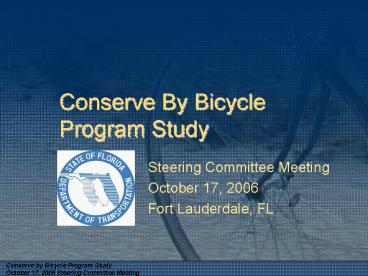Conserve By Bicycle Program Study - PowerPoint PPT Presentation
1 / 25
Title:
Conserve By Bicycle Program Study
Description:
Photo Credit: Sprinkle Consulting, Inc. Conserve by Bicycle Program Study ... restoration and conservation, parks & recreation, and energy conservation to ... – PowerPoint PPT presentation
Number of Views:40
Avg rating:3.0/5.0
Title: Conserve By Bicycle Program Study
1
Conserve By Bicycle Program Study
- Steering Committee Meeting
- October 17, 2006
- Fort Lauderdale, FL
2
Conserve by Bicycle Program
- Background
- In 2005, the Florida Legislature created F.S.
335.07, and the Conserve by Bicycle Program
within the Florida Department of Transportation.
3
Conserve by Bicycle Program
- Program Purpose
- Save energy by increasing the number of miles
ridden on bicycles, thereby reducing the usage of
petroleum-based fuels. - Increase the efficiency of cycling as a
transportation mode by improving the
interconnectivity of roadways, transit and
bicycle facilities.
4
Conserve by Bicycle Program
- Program Purpose (cont.)
- Reduce congestion on existing roads.
- Provide recreational opportunities for Floridas
residents and visitors.
5
Conserve by Bicycle Program
- Program Purpose (cont.)
- Provide healthy transportation and recreation
alternatives to help reduce trend toward obesity
and reduce long-term health costs. - Provide safe ways for children to travel to and
from their homes to their schools by supporting
the Safe Paths to School Program.
6
Conserve by Bicycle Program
- Your consulting team
- Sprinkle Consulting
- Bruce Landis, P.E., AICP, Project Manager
- Theo Petritsch, P.E., PTOE, Deputy PM
- Herman Huang, Ph.D.
- Peyton McLeod, AANG
- Christopher Fellerhoff
7
Conserve by Bicycle Program
- Your consulting team
- Kittelson, Inc.
- John Zegeer, P.E.
- Alan Danaher, P.E.
- Paul Ryus P.E.
- Rails-to-Trails Conservancy
- Ken Bryan
- Billy Fields
- Heather Dutch
- Cener for Urban Transportation Research
- Christopher Hagelin
8
Conserve by Bicycle Program Study
- The goals of this study are to determine -
- Where energy conservation and savings can be
realized when more and safer bicycle facilities,
such as bicycle paths, bicycle lanes, and other
safe locations for bicycle use, are created which
reduce the use of motor vehicles in a given area. - Where the use of education and marketing programs
can help convert motor vehicle trips into bicycle
trips.
9
Conserve by Bicycle Program Study
- The goals of this study are to determine -
- How, and under what circumstances, the
construction of bicycling facilities can provide
more opportunities for recreation and how
exercise can lead to a reduction of health risks
associated with a sedentary lifestyle. - How the Safe Paths to Schools Program and other
similar programs can reduce school-related
commuter traffic, which will result in energy and
roadway savings as well as improve the health of
children throughout the state.
10
Conserve by Bicycle Program Study
- The goals of this study are to determine -
- How partnerships can be created among interested
parties in the fields of transportation, law
enforcement, education, public health,
environmental restoration and conservation, parks
recreation, and energy conservation to achieve
a better possibility of success for the program.
The above stakeholder groups for instance, may be
brought into new or existing groups such as the
Bicycle and Pedestrian Advisory Committee
operated by Florida Department of Transportation.
11
Literature Search Approach
12
Marin Safe Routes to School
- Program started in 2000
- Participation in 2004-2005 37 schools with
16,261 students
13
Marin Safe Routes to School
- Program Components
- Education teach children cycling skills
- Engineering develop a plan to provide a safer
bicycling and walking environment - Encouragement events, contests, and promotional
materials - Enforcement targeted enforcement of speed
limits and other traffic laws
14
Marin Safe Routes to School
- Mode shift to bicycling
15
CATS Bicycle Survey
- Chicago Area Transportation Study (CATS)
conducted bicycle and pedestrian survey in 1995 - Bicycle survey
- 54 segments of 18 suburban trails (196 miles)
- 3,230 bicyclists
16
CATS Bicycle Survey
- How would you go where you are going now if this
trail did not exist? - 43 of work trips and 37 of non-work utilitarian
trips were diverted from auto to bicycle
17
Prediction Method - Delphi Technique
18
Case Study Candidates
19
Case Study Candidates
- Programmed facilities (imminent construction)
- Sunrise Blvd. (Broward County) bicycle lane
- Spring-to-Spring Trail (Volusia County)
independent alignment - Timucuan Route (Jacksonville) bicycle lane
- Existing facilities
20
Sunrise Blvd.
- Bicycle lane
- Plantation, Broward County
- From Hiatus Rd to Pine Island Rd
- Construction to start Jan. 2007
21
Spring-to-Spring Trail
- Independent alignment pathway
- Orange City, Volusia County
- From Lake Beresford Park to CR 4142
- Phase 4 construction to start Feb. 2007
Phase 4
22
Timucuan Bicycle Touring Route
- Bicycle lane/paved shoulder
- Big Talbot Island, Duval County
- Construction proposed in 2007
23
Candidate (Existing) Facilities
- Independent Alignments
- St. Marks (Tallahassee)
- West Orange (Orange County)
- Withlacoochee (Citrus, Hernando, and Pasco
Counties) - Sidepaths
- M Path (Miami-Dade)
- Warrington (Pensacola)
- 20th Street (Tampa)
24
Existing Facilities
25
Next Steps
- Develop data collection instruments
- Bicyclist user counts
- Bicyclist intercept surveys
- Collect before data
- Perform analysis
- Next Steering Committee meeting late January
2007































